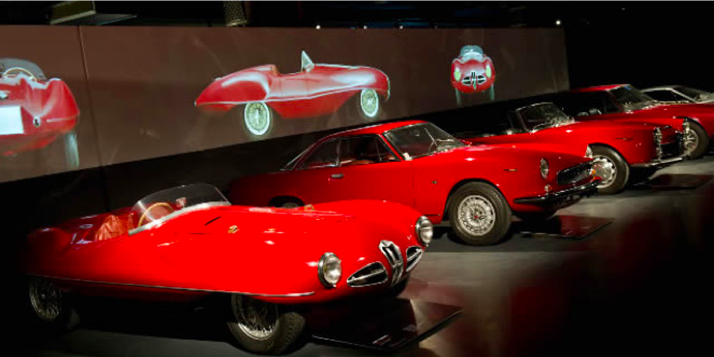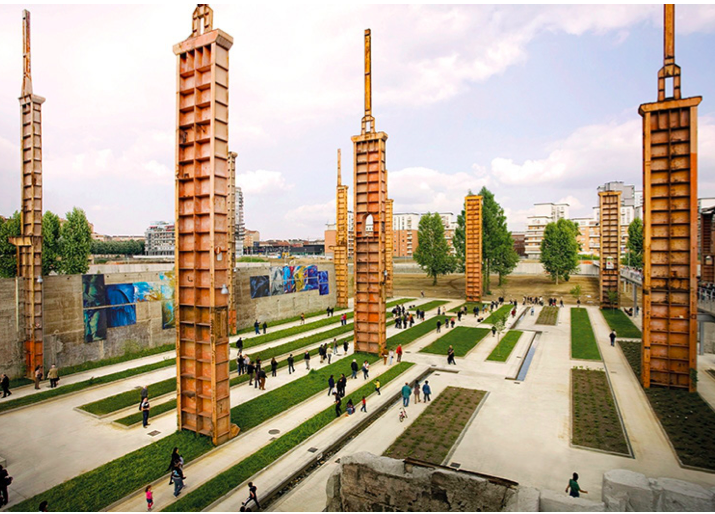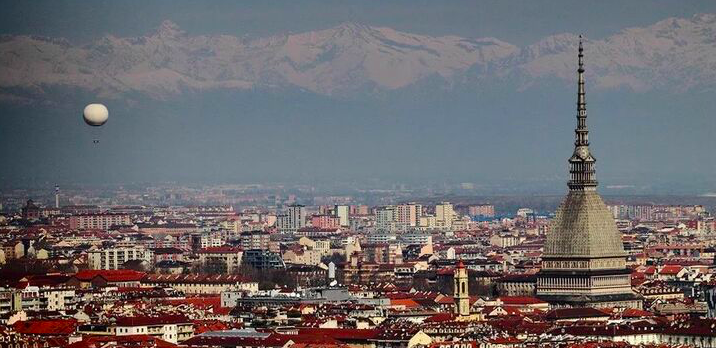Turin, the capital of Piedmont, is the third largest city of Italy. As the first capital after the reunification of Italy, Turin is rich in historical and cultural resources, preserving a large number of classical and Baroque architectures. After World War II, Turin's industry grew rapidly, especially in the automobile. Its urban economy is highly dependent on machinery and automobile manufacturing. The world- renowned automobile company, Fabbrica Italiana Automobili Torino (F.I.A.T.), has its headquarter and factory in Turin, making it the "City of Automobile of Italy" with its strong industrial strength playing an important role in the country's economic development.
In the early 1990s, Italy experienced a severe economic crisis, with industrial cities such as Turin being the hardest hit and the decline in industrial activity peaked in 1993, which seriously hampered the pace of urban development. Turin was a typical industrial city of post-Fordism period. Its large-scale factory relocations and closures produced more than 5 million square meters of industrial wasteland and the decline of its industrial activity has had a profound impact on urban form and material space.
The economic crisis and the negative impact caused by the development of industry prompted Turin to begin the urban regeneration and industrial transformation. In the process of promoting urban renewal, Turin City has upgraded its core industries with the advantage of industrial design, reshaped the city's creative space through the protection and utilization of its industrial heritage, and continued to explore historical and cultural resources to develop tourism. After more than two decades of reform and development, Turin has completed the transformation from an industrial city to a cultural city, and its development orientation has returned to culture. In 2014, Turin was awarded the title of "City of Design" by UNESCO as a member of the Creative Cities Network.
1. Automobile Industry Upgrading in Turin Makes it the "City of Design"
The automobile industry has always been the core and representative of the industry in Turin, which is thecentre of F.I.A.T. and the core of the Italian and even the whole-world automobile industry and automobile design and manufacturing. The automobile industry hasplayed a crucial role in Turin's economic boom, but its downturn also caused a rapid decline in Turin's economy due to the city's great reliance on it. As thecentre of Italy's automobile industry, a number of independent car styling studios and design companies have sprung up, such as the world-famous Pininfarina SpA, Gruppo Bertone, Torino Design, etc.; a quantity of world-class experts of car design have emerged, such as Giorgetto Giugiaro, Gandin, etc.; and supplies of the most classic cars in the world have been produced, such as Ferrari 250 GT, Maserati 5000 GT, BMW 3200 CS, etc. A wealth of design talents and strong research and development innovation capabilities are the secrets of Turin's automobile industry having the world-leading core competencies.

In the upgrading and transformation of the automobile industry, Turin has made full use of its advantages in automobile design to attract global design talents on the one hand, and also to enhance the international influence of the automobile industry on another. In 2005, the Turin Chamber of Commerce launched the "From Concept to Car" project to promote its unique car design abroad. The project leader pointed out: "60% of Turin's economy is dependent on exports. Nowadays, Turin should take advantage of all the research and development industry chain to change its economy from exporting products to exporting knowledge, technology, and know-how." The global project attracts automobile companies from all over the world every year. In 2014, Fiat and Chrysler Automobiles, one of the three major U.S. auto brands, formally merged as Fiat Chrysler Automobile (FCA), which further opened up the U.S. market and raised the international profile of Fiat and Turin. In the same year, UNESCO, after taking the overall development of Turin in terms of industry, culture, art and creativity into account, finally rated Turin as a creative city and awarded it the title of "City of Design".
2. Protecting and Utilizing Industrial Heritage
According to the Nizhny Tagil Charter, industrial heritages are industrial cultural relics of historical, technical, social, architectural, or scientific value, including buildings, machinery, factories, production workshops, factory mines, processing and refining sites, warehouse stocks, production sites, conversion sites, energy-using sites, transportation infrastructure, and other sites for social activities related to industrial production, such as housing, religious or education. After a mass move out of the car industry in the 1990s, a huge number of old factories and industrial land in Turin needed to be reopened.

From 1993 to 2001, Turin undertook a series of planning policy adjustments, and in 1995, The Comprehensive Master Plan of Turin proposed a transformation of the economic structure to develop the service sector by re-using industrial wasteland. Afterwards, factories were relocated to the suburbs and key areas were remodeled. For example, the Lingotto Factory, once Fiat's main building, was converted into a comprehensive service building that combines offices, hotels, theatres, concert halls, conference rooms, shopping centres and other functions altogether.
The famous Parco Dora in Turin is also a modern park designed by renowned German landscape architect Peter Latz and transformed from an industrial site by the riverbank. The park has five distinct areas, Ingest, Vitali, Michelin, Mortara and Valdocco, the first three of which are named after former factory sites, and the last two are located above the newly repaired tunnel. The refurbished River Dora area, with new residential buildings, new traffic trunks and recycled industrial sites, becomes a modern, green, stylish and avant-garde park.
After joining the Creative Cities Network, Turin has focused more on applying design to cultural heritage protection and hosts a number of creative design events each year to promote urban development. In October 2018, Turin launched a one-month project called "Turin. Towards an Accessible City", which aimed to use creative design thinking to protect cultural heritage. More than 150 institutions, large and small, were involved in the project, and there was a total of 160 specific activities, such as seminars, theatrical performances, concerts, films and exhibitions. At the same time, Turin successfully hosted the second"Torino Design of the City of 2018" which mainly focused on the revival of cultural heritage .
3. The Government System Conducts the over-all Planning of the Tourism Industry Development
Turin is rich in historical and cultural resources. But before the 21st century, Turin's tourism industry showed a depressed state, and specific manifestations of which were the lack of international tourism products and brands, the supply- driven market instead of demand- driven, the deeply rooted image as an industrial city, and insufficient attention to the development of tourism from the government. In 1998, in order to raise its international profile, Turin began to explore the Strategic Plan for the international Promotion of Turin, in which it was creatively proposed to create Turin as a city of "culture, tourism, trade and sport".

In the 21st century, the Turin Municipal Government has further recognized the driving role of tourism in urban transformation and social progress. In 2003, the Turin Tourism Bureau comprehensively formulated the overall tourism project in Turin, with the overall goal of developing a new tourism market through increasing the diversification of the tourism supply, with the focus on the development of business tourism with business talks and exhibitions as the main body and urban short- holiday leisure tourism with urban festivals as the principal part. Under the platform of government- enterprise cooperation, integrating and promoting the city's more than 40 museums, Baroque culture, architectural culture, as well as specialty food, including chocolate, wine and other local food, and ultimately making Turin a well-known special tourists' destination.
Since the development plan of the tourism industry was clarified in 2003, the tourism industry in Turin has made great progress in the following year, with a 13.7% increase in the number of tourists, and the majority of new visitors are new those who came Turin for the first time. To further release its cultural vitality, Turin has managed to shape the city's cultural brand by setting up institutions and hosting world-class cultural and artistic and sporting events. The Turin’s International Book Salon, held in Turin, has grown into one of the most famous book fairs in Europe, and Turin was named the World Book Capital City by UNESCO in 2006. In the same year, Turin successfully hosted the Winter Olympics, providing an opportunity for the local tourism industry to flourish. Since then, Turin has fully exploited its museum's resources, cultural and industrial heritage, and attracted more visitors through international conferences and colorful festivals. According to the Dati statistici sul Turismo in Piemonte (2018), Turin's tourism industry scale has been growing since 2009. The number of tourists in 2018 reached 7,248,575, with an increase of 2,87% from a year earlier, and the number of arrivals reached 2,505,985, with an increase of 1.58% on a year-on-year basis.
The overall tourism planning, rational use of industrial heritage, and various cultural and artistic activities have played an important role in Turin's transformation from an industrial city. Over the past few decades, Turin has successfully transformed itself from an industrial cCentre into a creative cCentre, becoming one of the most dynamic cities in Italian culture and creativity sector. Turin's creative and cultural sectors account for 9.1% of the total number of active institutions and companies in Italy and ranking third in Italy with approximately 100,000 employees.